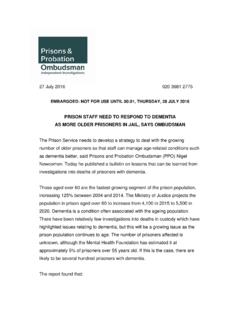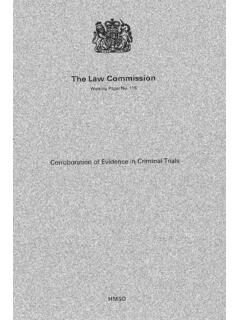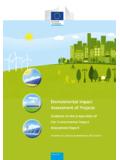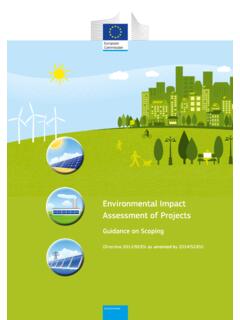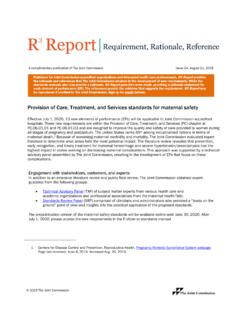Transcription of Modernising Communications Offences A final report
1 Modernising Communications Offences A final reportHC 547 Law Com No 399(Law Com No 399) Modernising Communications Offences Presented to Parliament pursuant to section 3(2) of the Law Commissions Act 1965 Ordered by the House of Commons to be printed on 20th July 2021 HC 547 I Crown copyright 2021 This publication is licensed under the terms of the Open Government Licence except where otherwise stated. To view this licence, visit or writ e t o t he Information Policy Team, The National Archives, Kew, London TW9 4DU, or email: Where we have identified any third party copyright information you will need to obtain permission from the copyright holders concerned. This publication is available at ISBN 978-1-5286-2771-9 CCS0621857840 07/21 Printed on paper containing 75% recycled fibre content minimum Printed in the UK by the APS Group on behalf of the Controller of Her Majesty's Stationery Office iii The Law Commission The Law Commission was set up by the Law Commissions Act 1965 for the purpose of promoting the reform of the law.
2 The Law Commissioners are: The Right Honourable Lord Justice Green, Chairman Professor Nick Hopkins Nicholas Paines QC Professor Sarah Green Professor Penney Lewis The Chief Executive of the Law Commission is Phil Golding. The Law Commission is located at 1st Floor, Tower, 52 Queen Anne's Gate, London SW1H 9AG. The terms of this report were agreed on 30th June 2021. The text of this report is available on the Law Commission's website at iv Contents Page CHAPTER 1: INTRODUCTION 1 The problem 1 The nature of online harms 3 Freedom of expression 5 This report 6 Origins of this report 6 Terms of reference 7 Consultation 8 Recommendations for reform 9 Evidence and problems of proof 12 Children and young adults 12 Acknowledgements 15 The project team 15 CHAPTER 2: HARM-BASED Communications OFFENCE 16 Introduction 16 Repeal of the existing Communications Offences 19 Consultation responses (repeal of existing Offences ) 20 Analysis (repeal of existing Offences ) 23 A new Communications offence 24 Harm 25 Consultation question 5 definition of harm 25 Consultation question 4 likely harm 35 Likely audience 40 Consultation question 3 likely to cause harm to likely audience 40 Consultation question 6 context and characteristics of audience 43 The Mental element intention 48 Consultation question 8 awareness of a risk of harm and intention 48 Without reasonable excuse 58 Consultation question 11 reasonable excuse 60 Consultation question 12 public interest 65 Sent or posted a communication 69 Recommendation 1.
3 71 Jurisdiction 71 Consultation question 16 extra-territorial application 72 Recommendation 2. 75 v CHAPTER 3: KNOWINGLY FALSE, PERSISTENT AND THREATENING Communications , AND FLASHING IMAGES 76 Introduction 76 Section 127(2) of the Communications Act 2003 77 Part 1: Knowingly false Communications 78 The proposed new offence: knowingly false Communications 78 Recommendation 3. 94 Part 2: Persistent use 94 Responses and analysis 96 Recommendation 4. 100 Part 3: Threatening Communications 100 Threats and the law 101 Victim impact and prevalence of threatening Communications 104 Use of Communications Offences 106 Analysis 107 Recommendation 5. 111 Part 4: Flashing Images 111 Recommendation 6. 113 CHAPTER 4: PRESS EXEMPTION 114 Consultation question and response 114 Analysis 121 Recommendation 7. 123 CHAPTER 5: GROUP HARASSMENT, GLORIFICATION OF VIOLENCE AND VIOLENT CRIME, BODY MODIFICATION CONTENT 124 Introduction 124 Part 1: Group harassment 125 Existing law: group harassment 127 Options for reform 130 Incitement or encouragement of group harassment 130 Knowing participation in pile-on harassment 143 Part 2: Glorification of violence and violent crime 150 Existing law, and the recommended harm-based offence 151 Justification and consultation responses 153 Conclusion 159 Part 3: Body modification content 159 Body modification: existing law 160 Consultation question and responses 161 CHAPTER 6: CYBERFLASHING 164 Introduction 164 The Rationale for reform 165 Harm 166 vi Prevalence 168 Current law 169 Cyberflashing.
4 A new offence 170 A sexual offence 171 The conduct element 175 The fault element additional intent 181 Conclusion 190 Ancillary orders and special measures 191 Recommendation 8. 193 Recommendation 9. 193 Recommendation 10. 193 Recommendation 11. 194 Recommendation 12. 194 Recommendation 13. 194 CHAPTER 7: GLORIFICATION OR ENCOURAGEMENT OF SELF-HARM 195 Introduction 195 Part 1: Existing position 196 Policy 196 Law 199 Part 2: Consultee responses glorification or encouragement of self-harm 203 Preliminary issue: online self-harm content and suicide challenges 203 Nonsuicide self-harm content and the harm-based offence 204 Encouragement of self-harm: should there be a specific offence? 209 Part 3: Encouragement or assistance of self-harm: a new offence 215 Threshold of harm 216 Fault element 219 Maximum penalty 220 Practical mechanisms: prosecutorial discretion and enforcement 220 Recommendation 14.
5 222 Recommendation 15. 222 Recommendation 16. 223 CHAPTER 8: RECOMMENDATIONS 224 Recommendation 1. 224 Recommendation 2. 225 Recommendation 3. 225 Recommendation 4. 226 Recommendation 5. 226 Recommendation 6. 227 Recommendation 7. 227 Recommendation 8. 227 Recommendation 9. 228 Recommendation 10. 228 Recommendation 11. 228 Recommendation 12. 228 Recommendation 13. 228 vii Recommendation 14. 229 Recommendation 15. 229 Recommendation 16. 229 CONSULTEES 230 GLOSSARY 232 1 Chapter 1: Introduction This report is the last of three Law Commission publications concerning harmful online Communications and the role of the criminal law in combatting that It is in this report that we make our final recommendations for law reform. The recommendations in this report are designed to modernise the criminal law: to ensure the law works effectively in the new technological paradigm, and is future-proofed; to ensure the criminal law can be a useful tool in protecting people from genuine harm and abuse; and, in a world where we communicate widely and publicly to share or challenge complex and controversial ideas, to ensure the criminal law allows space for that discussion and does not disproportionately interfere in people s legitimate freedom of expression.
6 We should be clear that the scope of these reforms extends beyond online Communications . While it is in the online space that the limitations of the existing law have been most illuminated, it does not follow that reforms should focus solely on online Communications . Indeed, the overwhelming tenor of the evidence we have seen is that the specific form of technology used is largely irrelevant to the potential for harm. The problem How we communicate in mode, in frequency, in content has fundamentally changed over the last two decades. It is worth recalling the opening paragraph of our consultation paper:2 When we published our report in 19853 leading to the enactment of the Malicious Communications Act 1988, only of UK households owned a home computer and the internet wouldn t be invented for another four Even in 2003, when the Communications Act 2003 was passed, only 46% of UK households had internet It was another year before Facebook was released (and, even then, available only to select universities and colleges).
7 Twitter was released in 2006. The first iPhone was not released until 2007, four years after enactment of the Communications Act. Nearly two decades later, in every single second that passes, 1 Abusive and Offensive Online Communications : A Scoping report (2018) Law Com No 381; Harmful Online Communications : The Criminal Offences (2020) Law Commission Consultation Paper No 248. 2 Harmful Online Communications : The Criminal Offences (2020) Law Commission Consultation Paper No 248, para 3 Law Commission, Poison-Pen Letters (1985) Law Com No 147. 4 J Schmitt and J Wadsworth, Give PC s a Chance: Personal Computer Ownership and the Digital Divide in the United States and Great Britain (2002) Centre for Economic Performance, London School of Economics, p 17. 5 Office for National Statistics, Internet Access households and individuals, Great Britain: 2018 (2018), p 3.
8 2 nearly three million emails are sent,6 nearly ten thousand Tweets are posted,7 and over three quarters of a million WhatsApp messages are sent [which by late 2020 was actually million per second],8 amongst the other terabytes of internet traffic per The suite of criminal Offences concerned with communication has, by comparison, changed very little. The constituent elements of section 127 of the Communications Act 2003, for example, (which prohibits certain Communications sent over a public electronic Communications network), draws heavily on its ancestor, section 10(2)(a) of the Post Office (Amendment) Act 1935. The section 127(1) offence makes it an offence for a person to send a communication over a public electronic Communications network (which would include the internet but exclude, say, Bluetooth or an intranet) that is grossly offensive, indecent, obscene or menacing.
9 The Malicious Communications Act 1988 prohibits Communications that contain threats or are grossly offensive or indecent; whilst it does not restrict the scope of the offence to Communications sent over a public electronic Communications network, the communication does have to have been sent to another , so limiting the use of the offence to address Communications posted in public fora such as Twitter and other social media platforms and websites. It is perhaps no surprise that criminal laws predating widespread internet and mobile telephone use (to say nothing of social media) are now of inconsistent application. The various challenges these formulations of Offences pose can be generalised in two ways. First, the laws under-criminalise. Many culpable and damaging Communications are left without appropriate criminal sanction.
10 The current Offences prohibit particular categories of content and, in some cases, particular modes of communication, but some abusive, stalking and bullying behaviours, despite causing substantial harm, simply fall through the cracks. Secondly, at the same time, the Offences over-criminalise. The scope of the existing Offences permits prosecutions that, absent the careful prosecutorial guidance we have seen, would be so great in number as to swamp the criminal justice system, and may nonetheless constitute an unjustifiable interference in freedom of expression. By proscribing content on the basis of apparently universal standards such as indecent or grossly offensive content the law criminalises without regard to the potential for harm in a given context. Two consenting adults exchanging sexual text messages are committing a criminal offence, as would be the person saving sexual photographs of themselves to a cloud drive.




